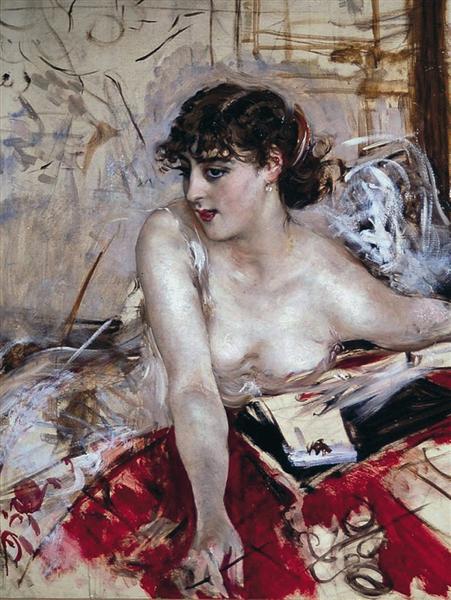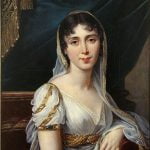Article made by Eleonor Nolan.
August 19, 2020.
Synopsis:
▪The mystery behind Marguerite Gautier’s death:

The facts of the story that will be told to us, begin to be revealed from certain circumstances occurred after the fatal outcome. In the first scene we see a young man of twenty-five years old in front of a poster on Laffite street, in the city of Paris. That poster announced an auction for March 16 of the current year, 1847, on d ‘Antin street, number 9. Visits could be made on March 13 and 14 to examine the objects and furniture to be sold.
This gentleman decided to go the next morning to see the flat. There he noticed the presence of women from the Parisian high society who were nosing around the rooms. The property had belonged to a deceased courtesan known as Marguerite Gautier.
(…) there were plenty of things worth buying. The furniture was superb; there were rosewood and Buhl cabinets and tables, Sevres and Chinese vases, Saxe statuettes, satin, velvet, lace; there was nothing lacking
(The Lady of the Camellias, Freedbooks’ editions, page 5).
On the afternoon of March 16, an incident took place that caught the attention of all those present at the auction.
“A volume, beautifully bound, gilt-edged, entitled Manon Lescaut. There is something written on the first page. Ten francs.”
(The Lady of the Camellias, Freddbooks’ editions, page 9)
“Twelve,” said a voice after a longish silence.
“Fifteen,” I said.
Why? I did not know. Doubtless for the something written.
“Fifteen,” repeated the auctioneer.
“Thirty,” said the first bidder in a tone which seemed to defy further competition.
It had now become a struggle. “Thirty-five,” I cried in the same tone.
“Forty.”
“Fifty.”
“Sixty.”
“A hundred.”
Our main character abandoned the avenue. An hour later, while resting at home, he held the copy of Manon Lescaut in his hands.
On the first page was written in ink, in an elegant hand, an inscription on the part of the giver. It consisted of these words:
(The Lady of the Camellias, Freddbooks’ editions, page 9)
Manon to Marguerite.
Humility.
It was signed Armand Duval
A few days later, a stranger knocked on this gentleman’s door. His servant opened and came back with a business card. It said: Armand Duval.
Mr. Duval was a man of the same age as the homeowner. Regarding his physical features, he was tall and with blond hair. At that moment he was dressed in a traveling suit. Mr. Duval, seeing his interlocutor stunned by his presence, apologized and communicated that he wanted to buy the book purchased at the auction. To his surprise, the next moment it was given to him as a gift.
“I knew Mlle. Gautier only by sight,” I said; “her death made on me the impression that the death of a pretty woman must always make on a young man who had liked seeing her. I wished to buy something at her sale, and I bid higher and higher for this book out of mere obstinacy and to annoy someone else, who was equally keen to obtain it, and who seemed to defy me to the contest.”
(The Lady of the Camellias, Freddbooks’ editions, page 11)
Moved, Armand took out a letter written by Margarita and handed it to his benefactor to read. Then, when it was returned to him, Armand brought the manuscript to his lips, shedding tears.
“And when I think,” he went on, “that she died before I could see her, and that I shall never see her again, when I think that she did for me what no sister would ever have done, I cannot forgive myself for having left her to die like that(…) I thought it was I who had to forgive her, and to-day I feel unworthy of the forgiveness which she grants me.”
(The Lady of the Camellias, Freddbooks’ editions, page 12)
Armand retired after promising his new confidant to tell him one day the reason of his suffering.
▪The last five years of life of the Lady of the Camellias:
To go into detail we must go back to a random day of 1842; the first time Armand Duval saw the courtesan.
The first time I ever saw her was in the Place de la Bourse, outside Susse’s; an open carriage was stationed there, and a woman dressed in white got down from it. A murmur of admiration greeted her as she entered the shop
(The Lady of the Camellias, Freddbooks’ editions, page 18).
Armand was so impressed with the girl’s beauty and elegance that he was unable to move from where he was standing until the lady departed in her carriage. A few weeks later, he had the opportunity to be formally introduced to her.
At that time, Armand was unaware of the lifestyle she led. He had a certain suspicion about it but the very idea was unbearable for him.
In a book of Alphonse Karr entitles Am Rauchen, there is a man that one evening follows a very elegant woman, with whom he had fallen in love with at first sight on account of her beauty (…) He scarcely dares glance at the trim ankle which she shows as she holds her dress out of the mud. While he is dreaming of all that he would do to possess this woman, she stops at the corner of the street and asks if he will come home with her. He turns his head, crosses the street, and goes sadly back to his own house
(The Lady of the Camellias, Freddbooks’ editions, pages 18 and 19).
Marguerite’s behavior, along with the friends she had, made it perfectly clear that she was a courtesan. The night Armand met her in her box at the Comic Opera, she humiliated him as any woman of her type would have done it.
Two weeks after that episode, Marguerite fell ill with tuberculosis. In consequence, she was no longer seen in the theaters she used to frequent. Armand, for his part, made various trips outside the country for a very long period of time. In this way a little more than two years passed.
On a spring evening in 1845, Armand saw the lady of the camellias again.
I had spent the day in the country with one of my friends, Gaston R—. We returned to Paris in the evening, and not knowing what to do we went to the Varietes. We went out during one of the entr’actes, and a tall woman passed us in the corridor, to whom my friend bowed
(The Lady of the Camellias, Freddbooks’ editions, page 18).
Whether he wanted to heal his pride, or he was touched by the love he felt for her, Armand behaved gently and gallantly with her. He also expressed concern about her health. That night, the courtesan became his lover.
The first seventy-two hours of their romance were so dizzying that anyone would have gone crazy. Armand abandoned his mistress on the second day after they began their relationships, and on the third day he begged her to accept him again at her side. Those days date from the month of April.
The following months, Armand consented the whims of Marguerite. At the same time, he tried to ignore the ties she was forced to maintain with other men to pay the expenses of her life full of comforts. However, two months later, Marguerite would surrender to the love she felt for him and would abandon all her suitors; even knowing that their romance would eventually come to an end.
In September, Marguerite abandoned Armand. In October, he decided to hold his former lover to account for her betrayal. In December, the woman would spend the year-end’s festivities in London, far away from the Parisian society to dispel the infamies spread against her. She returned to Paris in March 1846, and eight months later she was seriously ill and on the verge of death.
Critique:
▪Unresolved plot’s lines:
A) The past of Marguerite:
She grew up in the countryside as a child. When she arrived to Paris she didn’t even know how to read or write. However, we don’t know how she got to the Parisian city or how she managed to survive in it the first months or years. We also don’t know how she acquired the level of education she afterwards showed off, or how she acquire the notoriety she later enjoyed. These are questions that remain in a simple outline since the author has not taken the trouble to develop them.
b) The red camellias:
Marguerite used a bouquet of white camellias to complete her headdress. That bouquet was displaced by one of red camellias on certain occasions; supposedly five days a month. On this matter there is no clarification at all through the novel. Clearly this is a mistake on behalf of Alexander Dumas (son), since raising a question that seems substantial but later is not longer relevance is absurd.
▪Inaccuracy on the dates when the events took place:
Only two dates are mentioned correctly; March 12, 1847, and the month of November, 1842. The first refers to the auction, and the second refers to the return of Marguerite to Paris after her trip to Bagnères due to her illness. No other date is mentioned in the book. The dates specified in this article are the result of an approximate deduction taking into consideration some data provided by the characters.
▪Incomprehensible writing:
Alexander Dumas (son) prolongs certain scenes without moving on to more relevant ones; he also makes temporary leaps that make the reader lose; and he does not place grammatical pauses between each event which causes fatigue in reading the novel.
▪Forced dialogues:
There are some passages, written in a theatrical way, intended to induce the reader to make moral reflections. They are exaggerated and do not give importance to the novel.
▪Argument:
The plot is attractive but the story is poorly crafted. The book is a good draft of what would have been a great novel in the hands of another writer, such as his father.
Curiosities:
▪ The novel is inspired by Marie Duplessis’s life:
Marie Duplessis was a very beautiful woman who became known in France, in the 19th century, for her love affairs with men of outstanding social position. She was capable of manipulating her admirers to obtain what she wanted, and she knew how to conquer those few men who resisted her charms.
Some events reported in the novel happened in real life. However, the character of Marguerite Gautier is a romantic creation that bears no similarity to the character of Marie Duplessis. On the other hand, Marguerite Gautier died in a more dramatic way.
▪ The novel was highly successful despite its low literary value:
Marie Duplessis’s most scandalous relationships were with Alexandre Dumas (son), and with the renowned composer and pianist Franz Liszt. She also was well-connected with the Count François-Charles-Edouard Perregaux who she married in London. For a year, Marie Duplessis wore his coat of arms even though her marriage was not legal in France.
These details were known throughout Paris, so the book quickly gained notoriety when it was published in 1848, as the plot was known to be based on the woman’s intimate life.
Bibliography:
– En coulisses – Théâtre des Champs-Elysées. La vraie histoire de Marie Duplessis. Obtain from https://blog.theatrechampselysees.fr/la-vraie-histoire-marie-duplessis/
– Historia Universal. Marie Duplessis. Obtain from https://aminoapps.com/c/historia-universal-9046801/page/item/marie-duplessis/4Q8L_B4ivINPbzkjd1742xJLM67NmzenXK
-Normandy Then and Now. The Gacé Girl Who Became A Paris Queen; La Dame Aux Camélias. Obtain from https://www.normandythenandnow.com/the-gace-girl-who-became-a-paris-queen-la-dame-aux-camelias/
-Sandra Ferrer Valero. Mujeres en la historia. La dama de las camelias, Marie Duplessis (1824-1847). Obtain from https://www.mujeresenlahistoria.com/2015/12/la-dama-de-las-camelias-marie-duplessis.html



I agree with your opinion about the low literature value of the novel, despite its high success.